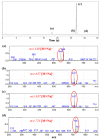Synthesis and Characterization of UV-Curable Resin with High Refractive Index for a Luminance-Enhancing Prism Film
- PMID: 39795478
- PMCID: PMC11723285
- DOI: 10.3390/polym17010076
Synthesis and Characterization of UV-Curable Resin with High Refractive Index for a Luminance-Enhancing Prism Film
Abstract
A novel monomer, 9-bis[4-(2-hydroxyethoxy)phenyl]fluorene di(mercaptopropionate), with a highly refractive index, purity, and excellent UV-curable properties, is synthesized through an optimized Fischer esterification process, reacting 9,9-bis[4-(2-hydroxyethoxy)phenyl]fluorene with 3-mercaptopropionic acid. The structural characterization of this monomer is performed using Fourier-transform infrared spectroscopy, nuclear magnetic resonance spectroscopy, high-performance liquid chromatography, and liquid chromatography-mass spectrometry. The synthesis conditions are optimized using a design-of-experiments approach. UV-curable resins are obtained by incorporating the synthesized monomer as the thiol component. The effects of thiol content on the UV-curing behavior, refractive index, shrinkage, adhesion to the polyethylene terephthalate (PET) foil, and viscoelastic recovery are examined. The thermal properties are assessed using differential scanning calorimetry and thermogravimetric analysis. Field-emission scanning electron microscopy confirms the successful replication of the prism film. In edge-lit light-emitting diode (LED) backlight units, the prism film showed increased luminance with higher thiol monomer content in the UV-curable resin while maintaining stable color coordinates. This novel highly refractive index monomer can be utilized in luminance-enhancing prism films, thereby contributing to future innovations in the display film industry.
Keywords: TFT-LCD; backlight; high refractive index; imprint; luminance; prism film; thiol–acrylate reaction.
Conflict of interest statement
Authors Jin Han Song, Seung-Mo Hong and Seok Kyu Park were employed by the company R&D Center, SHIN-A T&C. The remaining authors declare that the research was conducted in the absence of any commercial or financial relationships that could be construed as a potential conflict of interest.
Figures










Similar articles
-
Design and synthesis of bio-based UV curable PU acrylate resin from itaconic acid for coating applications.Des Monomers Polym. 2016 Oct 25;20(1):269-282. doi: 10.1080/15685551.2016.1231045. eCollection 2017. Des Monomers Polym. 2016. PMID: 29491798 Free PMC article.
-
Analysis and fabrication of a prism film with roll-to-roll fabrication process.Opt Express. 2009 Mar 16;17(6):4718-25. doi: 10.1364/oe.17.004718. Opt Express. 2009. PMID: 19293901
-
Synthesis, characterization, shrinkage and curing kinetics of a new low-shrinkage urethane dimethacrylate monomer for dental applications.Dent Mater. 2007 Aug;23(8):1030-41. doi: 10.1016/j.dental.2007.03.004. Epub 2007 May 9. Dent Mater. 2007. PMID: 17493674
-
Preparation and characterization of Bis-GMA-free dental composites with dimethacrylate monomer derived from 9,9-Bis[4-(2-hydroxyethoxy)phenyl]fluorene.Dent Mater. 2018 Jul;34(7):1003-1013. doi: 10.1016/j.dental.2018.03.007. Epub 2018 Apr 13. Dent Mater. 2018. PMID: 29661580
-
Screening of synthetic PDE-5 inhibitors and their analogues as adulterants: analytical techniques and challenges.J Pharm Biomed Anal. 2014 Jan;87:176-90. doi: 10.1016/j.jpba.2013.04.037. Epub 2013 May 6. J Pharm Biomed Anal. 2014. PMID: 23721687 Review.
References
-
- Alim M.D., Glugla D.J., Mavila S., Wang C., Nystrom P.D., Sullivan A.C., McLeod R.R., Bowman C.N. High dynamic range (Δn) two-stage photopolymers via enhanced solubility of a high refractive index acrylate writing monomer. ACS Appl. Mater. Interfaces. 2018;10:1217–1224. doi: 10.1021/acsami.7b15063. - DOI - PubMed
-
- Tang Y., Pina-Hernandez C., Niu Q., Nie J., Cabrini S. A novel high-refractive index episulfide-thiol polymer for nanoimprinting optical elements. J. Mater. Chem. C. 2018;6:8823–8831. doi: 10.1039/C8TC02029A. - DOI
-
- Lee J., Son J., Lim J., Kim I., Kim S., Cho N., Choi W., Shin D. Transformer-based mechanical property prediction for polymer matrix composites. Korean J. Chem. Eng. 2024;41:3005–3018. doi: 10.1007/s11814-024-00247-6. - DOI
-
- Higashihara T., Ueda M. Recent progress in high refractive index polymers. Macromolecules. 2015;48:1915–1929. doi: 10.1021/ma502569r. - DOI
Grants and funding
LinkOut - more resources
Full Text Sources
Miscellaneous

